Pte Josef (Jozek, Jozef) Poniedzielski (Podielzelsky, Paniedzielski, Podnielzlski) (1907–44) (B 133588)
Death in battle is different, Sam Chapman thought:
“He is cut down in an instant with all his future a page now to remain forever blank.
There is an end but no conclusion.”
– Capt Sam Chapman, C and D Coys
Introduction
For some decades now, I have had more than a passing acquaintance with the Roll of Honour published in 1953 in the so-called “Green Book.” The various lists compiled for it are indispensable, but imperfect. I have found Argylls missing from them, and today’s posting is an example. I found Pte Poniedzielski inadvertently, and his life’s tale is intriguing. There will be more to be told when archives reopen and there is access to documents. It is almost certain that there will be government files on him.
I acknowledge the assistance of Maj Tyler Wentzell of the 48th Highlanders, a historian with an intimate knowledge of Canadians who fought in the Spanish Civil War. Raymond Hoff is compiling a biographical dictionary of the “Mac-Paps” – the Mackenzie-Papineau – and other Canadians who fought in the Spanish Civil War. He generously provided source material from his own files. His work was a boon in sorting out the variations of Pte Poniedzielski’s name, among other things. As always, I have relied on Capt Caleb Zavitz, MD, an Argyll serving officer and vascular surgeon, for his appraisal of medical notes in a personnel file. I am grateful for his willing assistance even at the busiest of times.
Robert L. Fraser
Regimental Historian
Pte Josef (Jozek, Jozef) Poniedzielski (Podielzelsky, Paniedzielski, Podnielzlski) (1907–44) (B 133588)
DW 9 August 1944
Josef Poniedzielski was born in Częstochowa, Saskie, Poland, on 3 March 1907, one of the four daughters and two sons of Tonie Poniedzielski (1875—1930) and Saufie Sternik (1875—1920). Prior to the First World War, present-day Poland was a divided area. Josef Poniedzielski grew up in Russian Poland. Częstochowa was one of the emerging industrial centres. Between 1905 and 1907, the city was a hotbed of labour strife and nationalist movements. Poland itself was swept by socialist, nationalist, and agrarian ideologies. In 1897, it had a population of 45,130, of which about 25 percent were Jewish. During the First World War, the town was abandoned by the Russian Imperial army and occupied by the German army from 1914 to 1918. Late in 1918, units of the recently established Polish Army entered the town, which was a locus of support for the Silesian uprisings (1919—21) against the German Weimar Republic. The town lost its access to Russian markets. In the 1920s, unemployment was high in the aftermath of wartime losses. After a failed assassination attempt on Marshall Jozef Pilsudski and an associated coup in May 1926, he tried to assert greater control over the army. The onset of the Great Depression created havoc in Poland, and as the economy faltered, budget cuts hit the army.
“Polish Army, 1928 to 1929”
The context for Poniedzielski’s life in Poland is clear, but the details of his family and personal life are not. His mother died in 1920; his father ten years later. Poniedzielski had “7 years Public School” from “7 to 15 years (Attended in Poland.) [to c. 1922].” According to his Canadian military file, he had served with the “Polish Army, 1928 to 1929.” Within an atmosphere of economic turmoil, political instability, dismal economic prospects, and familial disruption, Josef Poniedzielski immigrated to Canada on 26 July 1930 aboard the Volendam. According to immigration records, his brother Stanislaus Poniedzielski (b. 1896) paid for the trip, and his sister, Natalie Poniedzielski, was living in Toronto at 698 Adelaide Street, a two-bedroom, one-bath, semi-detached house; he gave his occupation as “painter.” In 1942, he had one sister living in Poland, one in the United States, and two in Toronto. His precise whereabouts during the 1930s are unclear. There are two listings for him in the Toronto city directories from 1931 to 1942: one in 1936 listing him as a “heeler” at “American Footwear” and living at 695 Adelaide West; the other in 1942, in which he is a “lab.” living at 695. One source suggests he lived in Montreal, but a search of the city’s directories from 1931 to 1936 reveals no entries for him.
Apparently, Poniedzielski either belonged to, or was affiliated with, the Young Communist League of Canada by 1935. Founded in 1922, the league had considerable success in Canada’s major cities, including Toronto and Montreal during the 1920s and the 1930s. The depression, massive unemployment, labour strife, the On-to-Ottawa trek of 1935 and the riot in Regina by trekkers focused attention on the structural problems of Canadian society. A decade of turmoil witnessed the rise of both right- and left-wing radicalism across the country. Communism, socialism, and pacifism reached their zenith of popularity. It is impossible to know what Poniedzilski believed or what groups he joined without the benefit of accessing a probable RCMP file on him; hopefully, it will, if there is one, provide more detail about his activities in the 1930s. The league had a decided anti-fascist bent and viewed European developments with alarm and conviction – the rise of fascism in Italy and Nazism in Germany. In July 1936, Spanish fascist and extreme right elements orchestrated a coup against the country’s elected Republican government. The uprising became known as the Spanish Civil War. It lasted from 1936 until the victory of Francisco Franco’s nationalist forces in 1939. Until then, the war was a cause célèbre and rallying point for anti-fascists and communists around the world, including Canada. Over 40,000 women and men went to Spain to join the republican cause. Canada provided the famed Mackenzie-Papineau Battalion, and almost 1,500 Canadians joined the international brigades.
“in transit to Warsaw, Poland”
Apparently, the war and its cause inflamed Poniedzielski. He left New York, via Halifax, on the Ascania, a Cunard Line ship. Listed on its passenger list as a Polish citizen residing in Canada (he had not been naturalized), he was purportedly “in transit to Warsaw, Poland.” Instead, after arriving in England on 9 February 1937, he joined the XIII Brigade, also known as the Dąbrowski Brigade after Jaroslaw Dąbrowski, a Polish general who died in France defending the Paris Commune in 1871.
“suggestive of … membership in the Communist Party”
Historian Wentzell suggests that this gentleman’s date of enlistment is suggestive of his having and maintaining membership in the Communist Party [CP]. “He joined [the International Brigade] just at the point when the members of the ‘legalized’ CP, operating as the Labor-Progressive Party, were permitted by Ottawa to join the military and the LPP encouraged its members to do so. It’s circumstantial …”
On 18 October 1938, Poniedzielski was a “regular” soldier in the international forces. He was with the 129th International Brigade at Villanueva de Castellón in December 1938 before moving to Cassà de La Selva, a municipality in Catalonia, on 19 January 1939, exactly one week before Franco captured Barcelona. Col O’Kelly, an RCMP officer working with the High Commission in London, went to Ripoll, a Spanish town near the French border, to determine eligibility of Canadian volunteers to return to Canada. Poniedzielski was a Polish citizen, not a naturalized Canadian. According to historian Wentzell, there was a need to prove residence in Canada for five years. Whatever happened, Poniedzielski was rejected and probably entered France after the borders were opened early in 1939. He spent approximately three months in a French detention camp until returning to Canada on the Duchess of Atholl on 20 May 1939. In his enlistment interview, Poniedzielski stated that he was a “worker in Sand mine – France” for 1 year.
“Spanish Civil war … his war experience should make him a good man for C.A.C.”
According to his occupational history form, prior to enlistment in 1942 he worked three years as a “Frame Maker” at the Imperial Woodworking Co. on Sterling Road in Toronto, where he was a “sander.” Furniture making was a thriving industry – Ontario alone had 189 establishments – that catered mainly to the domestic market. He enlisted in Toronto, Ontario, on 6 October 1942. An “Artist (Painter),” he “States he had abscess on back rt. shoulder opened & drained – while in Polish Army … No present disability.” He was over 5’ (the record omits how many inches), 130 lbs, with blue eyes and brown hair. Lt Earle Birney (1904—91) conducted the interview on the 7th. Birney was a poet, later a renowned one, and prominent socialist and Trotskyite in the 1930s. A personnel officer during the war, he later used his experiences for writing his humorous novel about the war, Turvey (1949). Poniedzielski had been a shoemaker for six years, a statement that accords with the city directory of 1936. He was a woodworker for the three years before enlisting, a “Member – International Bde – Spain 2 years,” and “attending Art School 3 years.” It is unclear whether art school was in Canada or in Poland; it may have been the later, his immigration record of 1930 lists his occupation as “Painter”; he had no farming experience, expressed no desire to return to his pre-enlistment job, and hoped to be an auto mechanic after the war. He spoke Polish, Russian, Spanish, and English. Birney, probably sympathetic to his service in Spain, wrote:
A well developed Polish man of 35 years of average intelligence and fair stability. Robust, good appearance, single, can speak Russian, and Spanish fluently, also Polish. Was used as interpreter in Spanish Civil war. Wants to go to C.A.S. OTHERS and his war experience should make him a good man for C.A.C. as his low score [on the M tests] is perhaps fairly due to language difficulties.
The recommendation is unsurprising: “C.A.C. OTHERS non tradesman.”
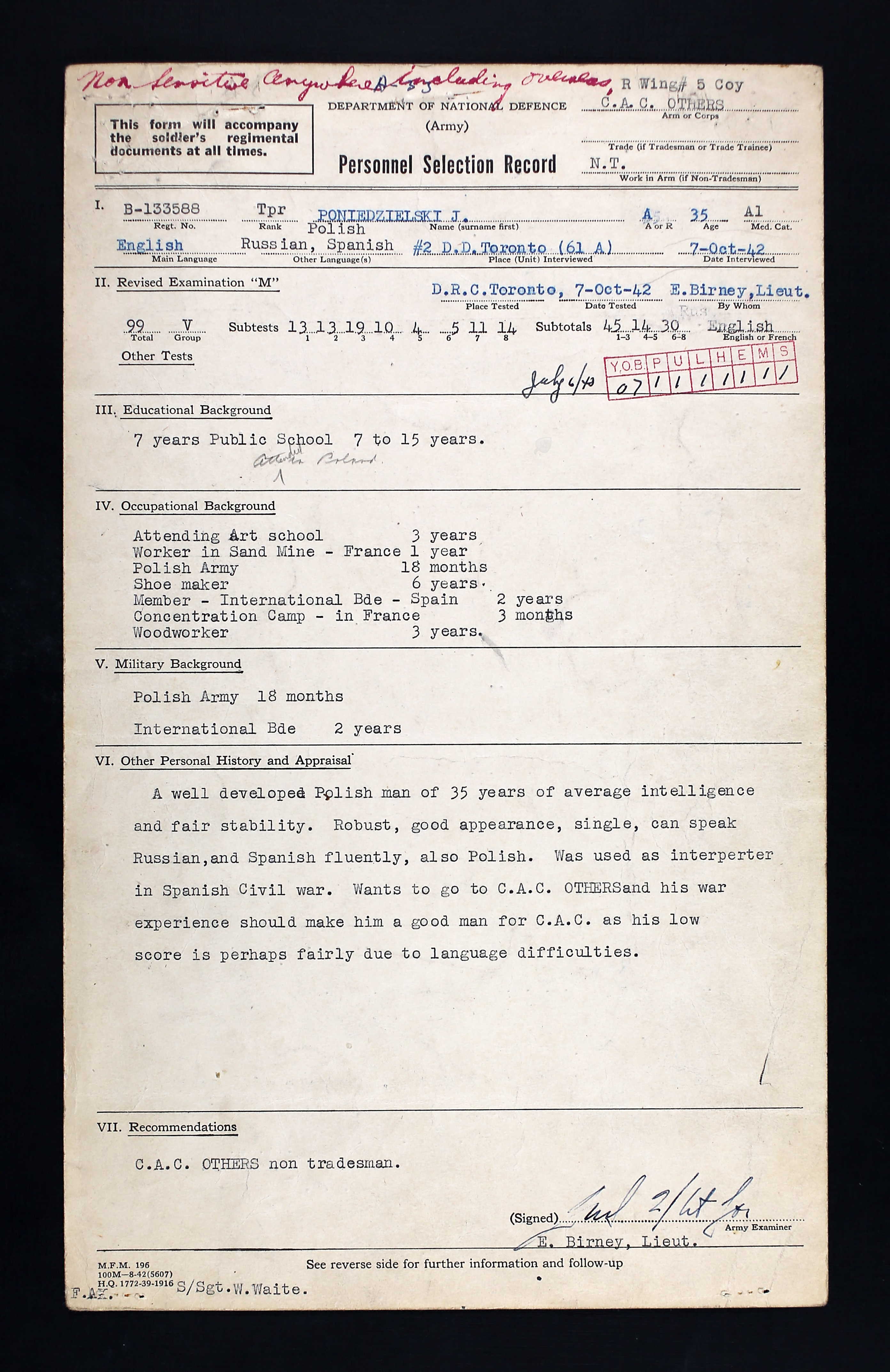
“Non Service Anywhere Including overseas”
A note written across the top of his Personnel Selection Record reads: “Non Service Anywhere Including overseas.” Birney’s unqualified recommendation did not carry the day. The scribbled note almost certainly ensured further interest and a pause in the process. Pte Poniedzielski was taken on strength at No.43 Basic Training Centre in Sherbrooke, Quebec, on 19 December 1942 and granted a “New Year’s leave and allowance” the next day. On 24 February 1943, he went to Camp Borden for advanced training. On 30 March, he received permission to marry “on or after 15 Apr 43.” The permission was cancelled the same day. He received an increase of pay from $1.30 to $1.40 daily on 6 February 1943 and then to $1.50 on 6 April.
“questioned [him] closely in view of his past record”
The army interviewed Poniedzielski again on 10 March 1943:
… and questioned [him] closely in view of his past record and possible use to the Canadian Army. Speaks Russian, Spanish and can carry on conversation in any Slavish language well enough to make self understood. Has talked with Jugo Slave [sic] and Bulgarians and Ukrainians.
This mans [sic] education was in Polish and has never had any English schooling. In view of his low normal score in M test this man is referred to psychiatrist for opinion on mentality before allocation is made. Army examiner feels that this man has good average intelligence.
The interviewer recommended: “Psychiatric Referral.”
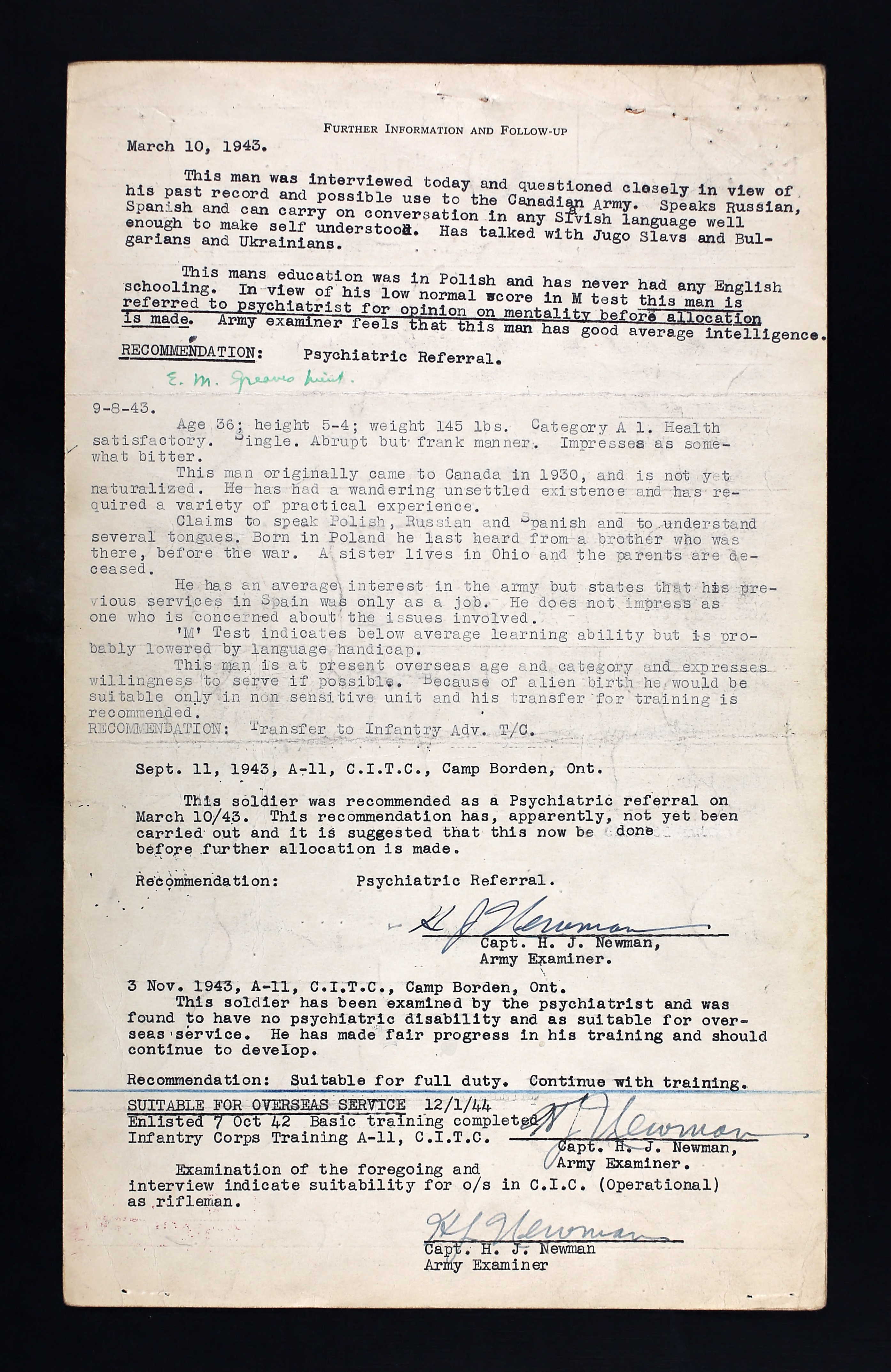
“a wandering unsettled existence”
The next interview came on 9 August 1943. He had gained weight and was now 145 lbs and 5’ 4”. His medical category was A 2 and his health “satisfactory.” He had an “Abrupt but frank manner. Impresses as somewhat bitter.”
This man originally came to Canada in 1930, and is not yet naturalized. He has had a wandering unsettled existence and has required [acquired?] a variety of practical experiences.
Claims to speak Polish, Russian and Spanish and to understand several tongues. Born in Poland he last heard from a brother who was there, before the war. A sister lives in Ohio and the parents are deceased.
He has an average interest in the army but states that his previous service in Spain was only as a job. He does not impress as one who is concerned about the issues involved.
“M” Test indicates below average learning ability but is probably lowered by language handicap.
This man is at present overseas age and category and expresses willingness to serve if possible. Because of alien birth he would be suitable only in non sensitive unit and his transfer for training is recommended.
Whatever the truth of Poniedzielski’s statements, it seems reasonable that he would have downplayed any ideological commitment and he did have a job in Toronto in 1936. This examiner concluded that there was no reason for further delay and recommended “Transfer to Infantry Adv. T/C.”
“has a fine army attitude and a good fighting spirit”
Poniedzielski had no minor infractions during his first months in the army. He was taken on strength from A-33 CACTE Technical and Schools Wing. He was again granted permission to marry on 1 September. Problems came in September, likely connected to his intention to marry and his fiancé’s pregnancy. He was awarded three days confined to camp on 9 September for being AWOL from 1200 hrs 6 September until 1200 hrs 8 September; he also forfeited two days’ pay. At yet another interview on 11 September 1943, Capt H.J. Newman pointed out that the suggestion of 10 March for psychiatric referral had “not yet been carried out and it is suggested that this now be done before further allocation is made.” He talked to Poniedzielski again on 3 November. He “has been examined … and was found to have no psychiatric disability and as suitable for overseas service. He has made fair progress in his training and should continue to develop.” He was “Suitable for full duty. Continue with training.”
Pte Poniedzielski’s personnel file records his marriage on 4 December 1943 at Cornwall. His bride, Elizabeth Mary Sawinski (1920—2002), was the Toronto-born daughter of Romanian-born Jacob Nicholas Sawinski (1894—1973) and the Scottish-born Elizabeth Ann Robertson Wells Hunter (b. 1898— ?). Jacob was in Canada, Cornwall specifically, by 1916; Elizabeth’s family was in Canada a year earlier. Pte Poniedzielski’s daughter, Camille Mary Rosalie, was born on 4 December. He received “5 days Xmas leave” and $.50 “per diem allowance.” On 12 December, Newman deemed Poniedzielski “suitable” for overseas service. “Examination of” his completion of basic training “and interview indicate suitability for o/s in C.I.C. (Operational) as rifleman.” He had embarkation leave from 3 to 6 January 1944 plus a meal allowance.
“apprehended at Riviere Du Loup, Que. at 1715 hrs 21 April 44”
The “examination” of his personnel selection documents was completed at Debert, Nova Scotia, on 11 April 1944 and approved. A note on his Service and Casualty Form reads: R.C.M.P. (8 x13) form completed: Non Sensitive Anywhere including overseas Can Inf Corps.” The prospect of leaving his family did not, apparently, sit well with him. He was awarded “14 days CB for conduct to the Prejudice etc in that he when apprehended at Rivi[è]re [d]u Loup, Que. At 1715 hrs 21 April 44 was in possession of a pass for Halifax, N.S. Placed under stoppages of pay amounting to $28.04 costs of apprehension and return to unit.”
“has a fine army attitude and a good fighting spirit”
Pte Poniedzielski left Canada on 26 June 1944, disembarking in the United Kingdom on 3 July. He was taken on strength No. 3 Canadian Reinforcement Unit (CIRU) the next day. There, on 4 July, the interviewer remarked: “This man has a fine army attitude and a good fighting spirit. Suitable for Gen Duty in INF.” The minute in his record for 20 July reads: “SOS to X-4 List (CIC) (A&SH)”. His wife, now residing at 123½ 7th Street, “East” Cornwall, Ontario, was listed as his next of kin.
 Service and Casualty Form.
Service and Casualty Form.
Poniedzielski was taken on strength the X4 list on 25 July and struck off the next day to the Argylls. Unfortunately, there is no record of his posting in Part 1 appendices to the unit’s war dairy for July or August. Records were lost at Igoville (see Pte Joe Bearss) on 29 August 1944 and the capture of a portion of Headquarters Company (records were destroyed). He joined them at Tierceville, Normandy, where that day the “remainder of the Bn arrived.” It was “clear and sunny, with slight rain at night.” By 2300 hours, “every one was in the camp area.” Presumably, he was posted to a rifle company. Without knowing his company, it is impossible to provide any precision about his movements over his 14 days as an Argyll in action. Initially, it was warm and dull, they ate rations and scrounged for extra food. There was much commotion and a gradual move to the front. They got their first look at “former battlefields,” and then the stench and destruction of Caen, mass graves bulldozed for casualties, German shelling, the first deaths of Ptes Percy Hindle and William Daniel McCann, the bugs, the dust, and the continuous “horrific” shelling at Bourguébus, where Pte Bannatyne was killed. The Argyll attack at Tilly-La-Campagne on 5 August failed, leaving behind more casualties, among them ACpl Gooderham, Pte Carlton, and Pte Wingate.

“first treatment to the wounded … sort out those that should be transferred back as fast as possible”
Pte Poniedzielski was wounded severely on 8 August, but where and precisely when is a mystery. The war diary entry for the 7th characterizes the day as “uneventful.” Three Argylls were wounded, none killed. Operation TOTALIZE began at 2300 hours on the night of the 7th with a massive air raid by the Allies and an intensive artillery barrage. The battalion was in Vaucelles and moved out in the morning. The attack on Cintheaux came later in the day. In this brief action, Pte Bill Wingate was killed.
Poniedzielski’s wound occurred in the early hours of the 8th and by a gun shot. His field medical cards are definite on that point. The timing is somewhat bewildering because there is no mention of enemy action or fire in the war diary nor in interviews with veterans, their reminiscences, or their letters and diaries. Yet, the field medical cards are unequivocal about the days and the timings of treatments and medications. The first specific time is 0350 hours on 8 August, then 0430. There is no time attached to Pte Poniedzielski’s arrival at the Regimental Aid Post. There, the medical officer (MO) had one imperative. As a later Argyll Mo, Capt Doug Bryce, expressed it:
…his job in action was to follow the line of attack … to give first treatment to the wounded and to sort out those that should be transferred back as fast as possible and those that could be put off for a few hours. His management of wounds was essentially massive first aid [and] the use of blood and plasma where indicated.
“Penetrating chest wound. Shock.”
Poniedzielski was, it seems, “transferred back as fast as possible.” The unit MO scrawled on his medical card “G.S.W.[gunshot wound] penetrating.” The first note of 18 Field Ambulance, which was responsible for evacuating him, has no precise time attached, it merely confirmed “GSW chest.” He was taken to 21 Canadian Field Station, which provided intermediate levels of treatment, and admitted at 0350 hours on the 8th with “Penetrating chest wound. Shock.” He had “mod.[erate] shock B.P. 70/? With considerable blood loss.” At 0430 he received plasma and blood; he was “Spitting blood.” At 0505, he was assessed at No 2 Canadian Casualty Clearing Station (a basic hospital for surgery). He was “breathing [with] greatest difficulty” and had “Lost a great deal of blood.” “Will surgeon see please. Condition fair.” At 0030 hours on the 9th, he had a “troublesome cough” and deemed “Ready for closure wounds. Respiration now seems easy. Is unconscious + feels not to[o] badly.” At 1000 surgeons operated on the wound of entry and exit, both “sucking” wounds.” They were “excised + muscle layer closed.” The bullet had, the surgeon reported, “Miraculously missed main structures of mediastinum.” They finished operating at 1030 and one hour later Pte Poniedzielski “Died” of “circulatory collapse.”
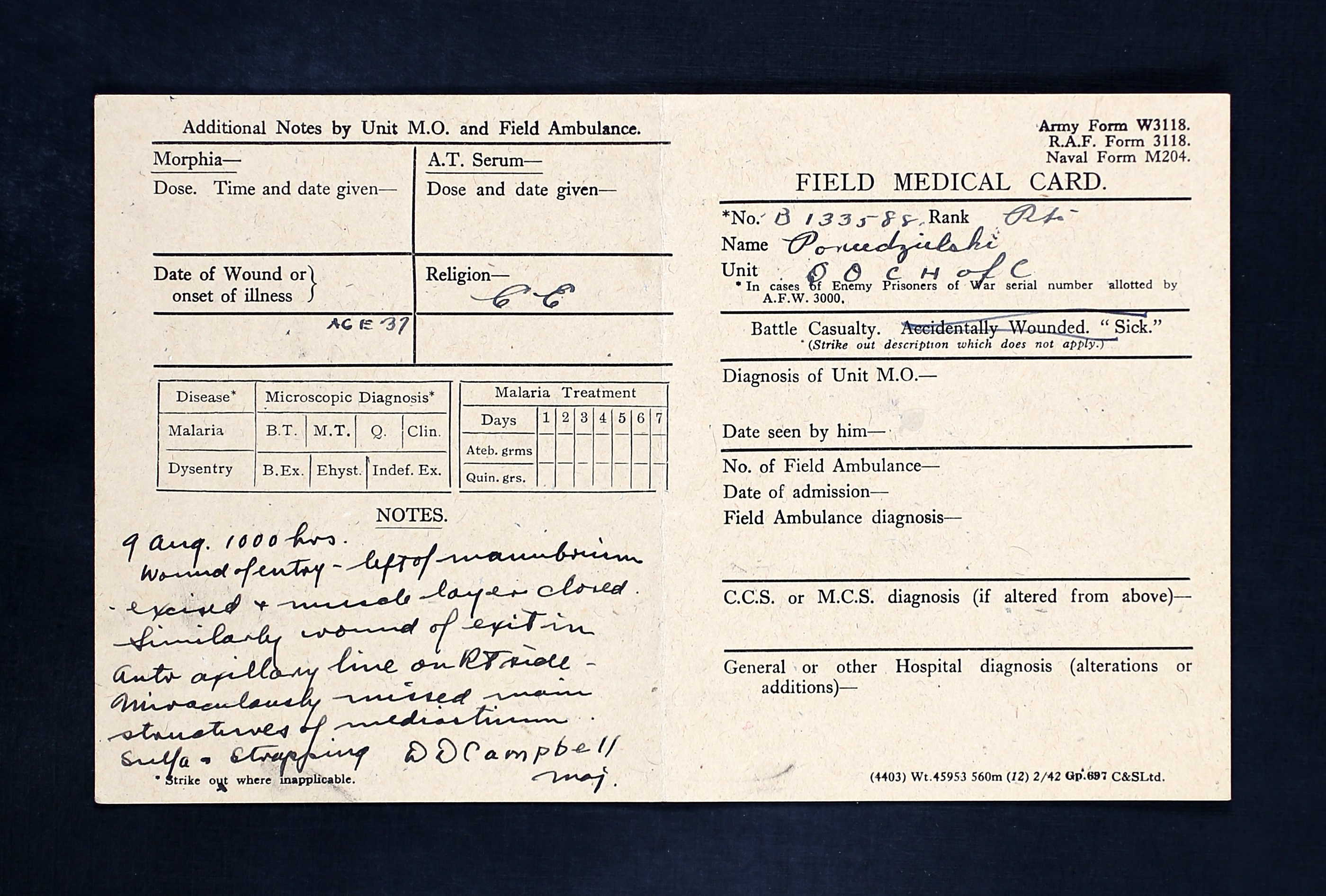
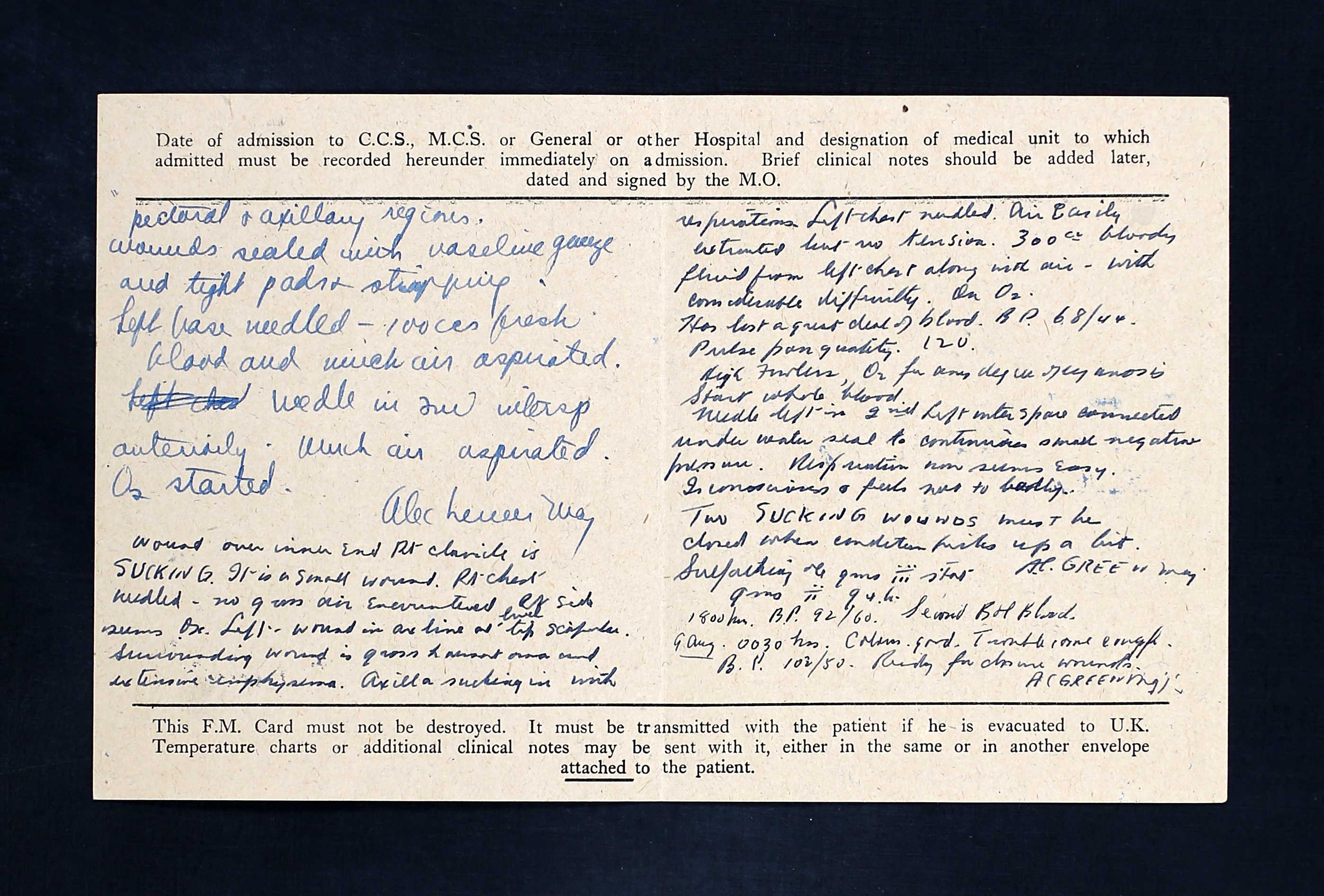
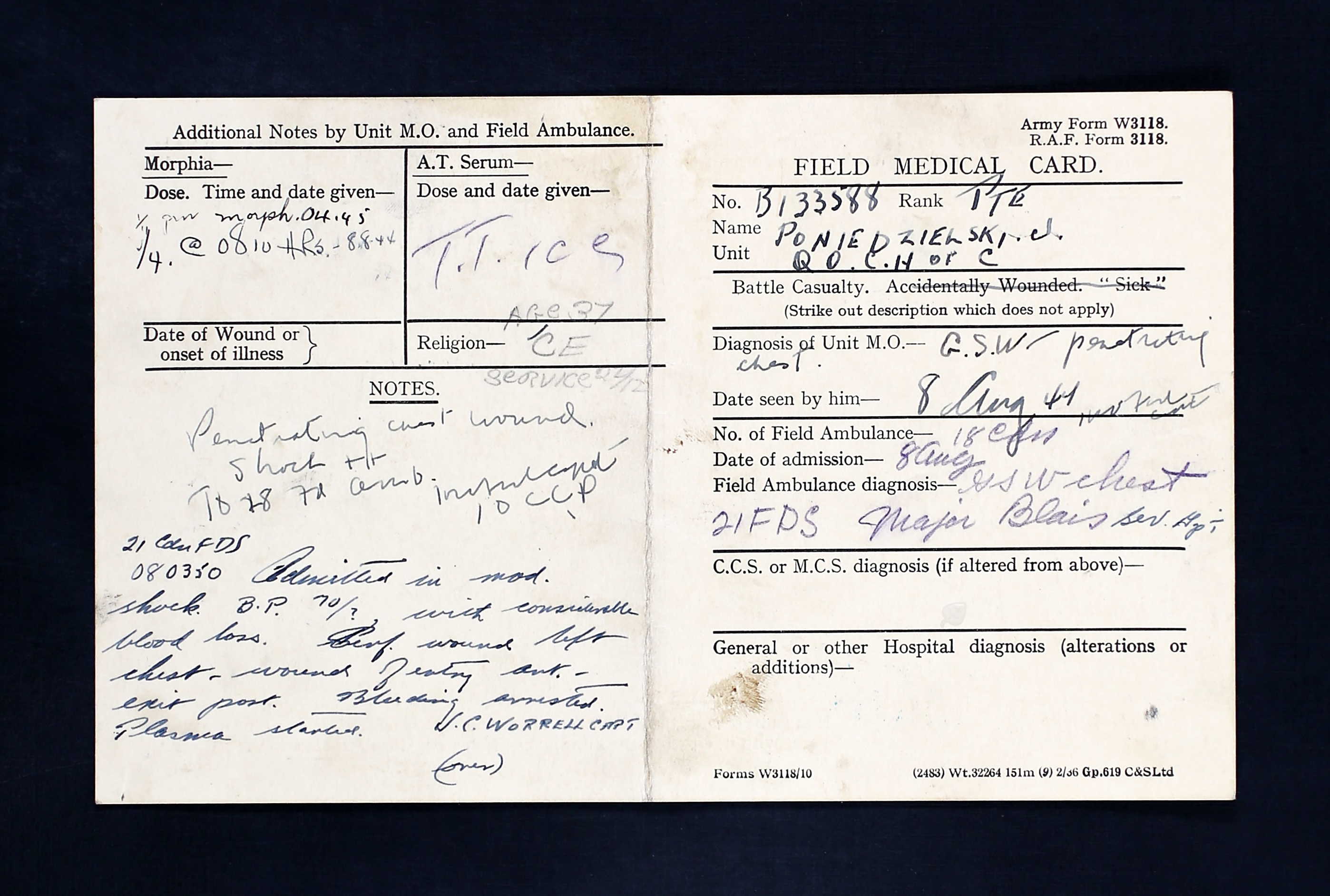



“Died” of “circulatory collapse”
Capt Caleb Zavitz, MD, a vascular surgeon and serving Argyll officer, offered this assessment:
[His] wounds weren’t survivable, and he died a day after getting hit. Cause of death is listed as “circulatory collapse,” which could be either a tension pneumothorax or simply bleeding to death. Without modern surgical capabilities, a gunshot wound through the chest from one side to the other would have been shocking to survive. Docs did their best with what they had available, but his wounds were too severe.

Elizabeth Mary Poniedzielski received a telegram on 14 August, informing her that he “has been officially reported severely wounded.” Two days later, another telegram conveyed a stark message of devasting finality: “died of wounds … bullet wound to chest.” Pte Poniedzielski left little: a “damaged wrist watch, a wallet, a coin, a religious medal, 4 erasers, his identity disc,” some “Snapshots & Photos,” a notebook, a single letter, and 2 handkerchiefs (“destroyed, badly soiled, Bloody”). There were also a Polish dictionary and an address book.
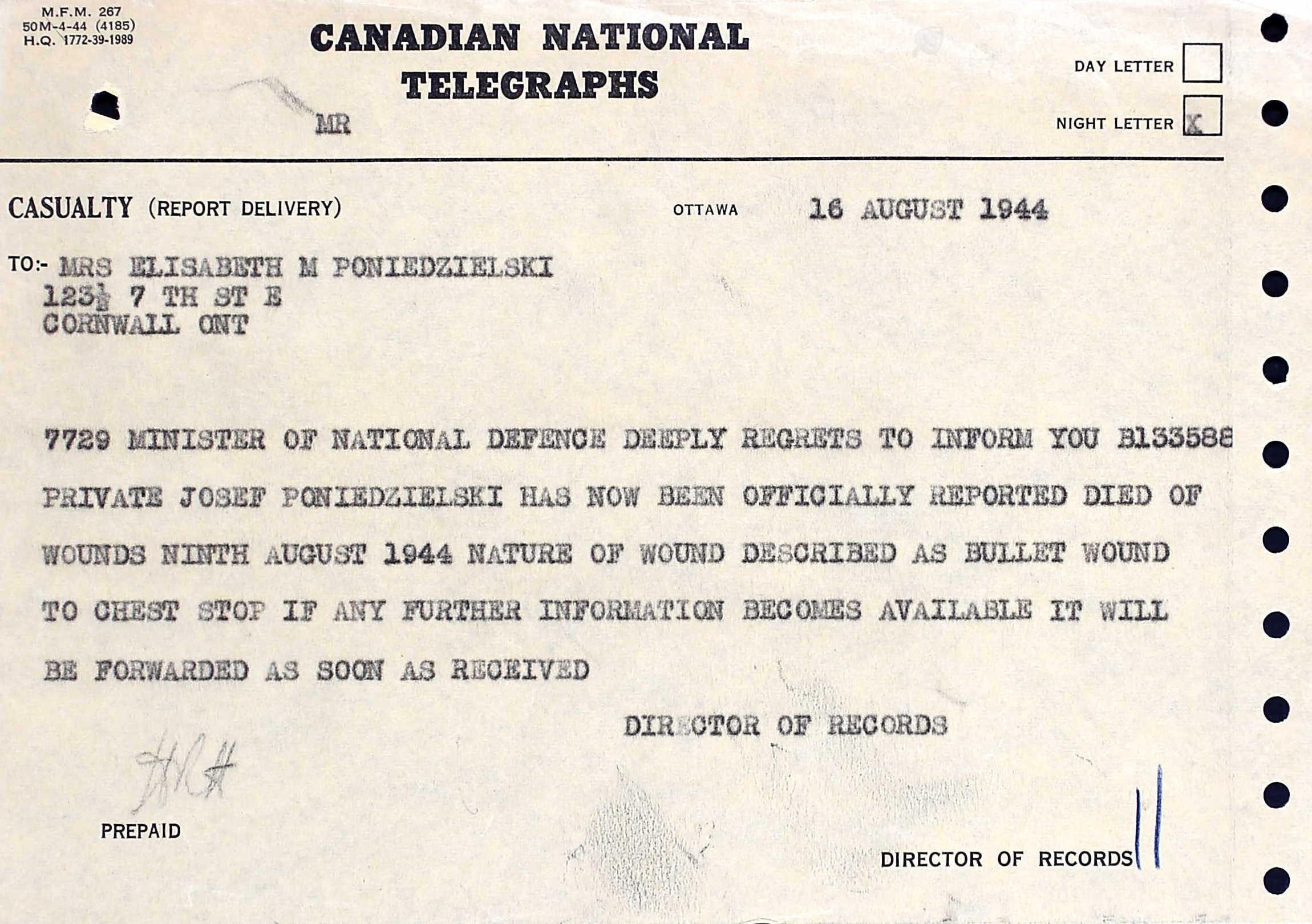
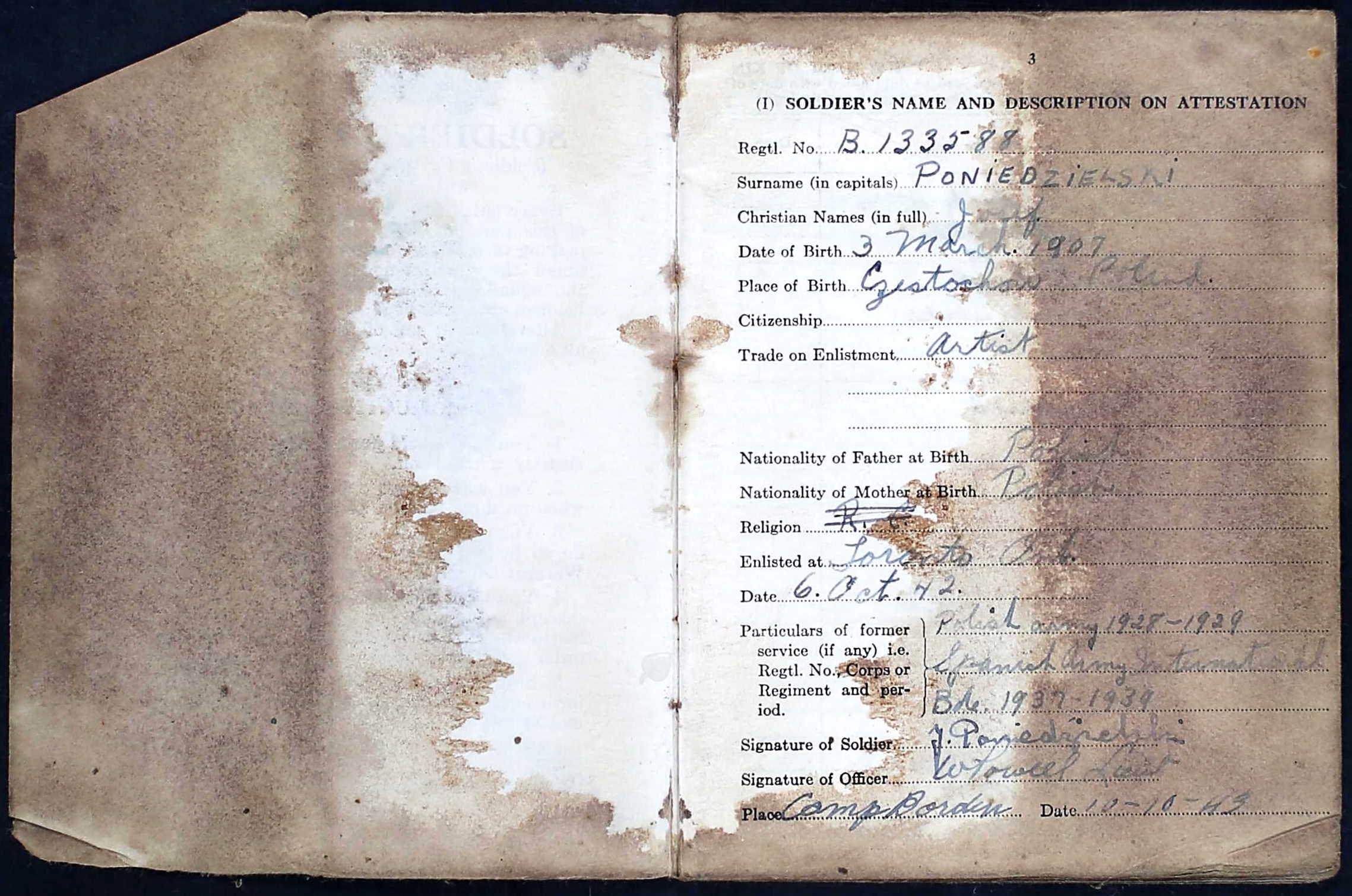
According to his attestation paper, Pte Poniedzielski was Roman Catholic. HCapt Charlie Maclean, the Argylls’ padre, buried him in a temporary grave with a short reverent service and a piper playing the battalion’s lament, “Flowers of the Forest.” His gravestone at Bény-sur-Mer Canadian War Cemetery reads:
LOVINGLY REMEMBERED
BY YOUR WIFE MARY
AND DAUGHTER CAMILLE

The “wandering unsettled existence” ascribed to Pte Poniedzielski ended in Normandy, far from Poland, far from Spain, and even farther from Canada. His life is a puzzle with many missing pieces. An artist who hoped to be an auto mechanic after the war; a soldier in three different armies, two defined by nationality, one by ideology; a woodworker (framer) and shoemaker (heeler); a linguist; a man who left a society in economic and political tumult; a man who went to a society riven by ideological civil war; a man who came to Canada, left it, came back, and left again; a man who went AWOL from Nova Scotia to return to his new wife and child – Josef Poniedzielski was all of these, a man whose wandering and unsettled life may have given way to a purpose and a path ahead were it not for a war and his death in battle.
Mary had three husbands during her life. They all predeceased her, and all of them, including Josef Poniedzielski, were mentioned in her obituary of 2002. Various organizations devote themselves to remembrance of Canada’s fallen. To that end, they look for images – images of the men themselves, their families, and their gravestones – to add to several online memorials. His daughter, Camille Norton, provided them with images of her father, her mother, and herself – “lovingly remembered” still.
“a history bought by blood”
– Capt Sam Chapman, C and D Coys
“Death in battle is different” – We shall remember him – The Argyll Regimental Foundation on behalf of the serving battalion and the Argyll Regimental family
Robert L. Fraser
Regimental Historian
Note: Pte Poniedzielski’s poppy will be placed in the virtual Argyll Field of Remembrance in the near future. The Argyll Regimental Foundation (ARF) commissioned Lorraine M. DeGroote to paint the Argyll Poppy for the Field of Remembrance.

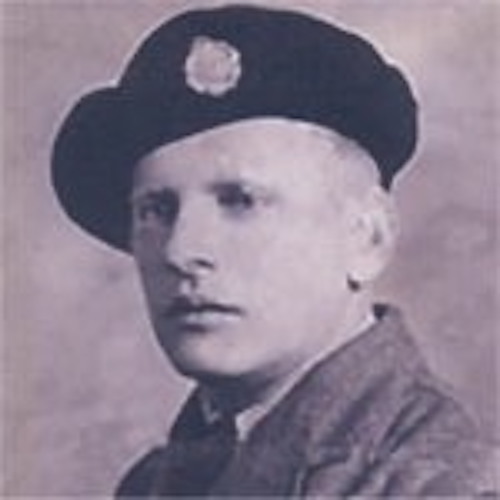 Pte Josef Poniedzielski
Pte Josef Poniedzielski
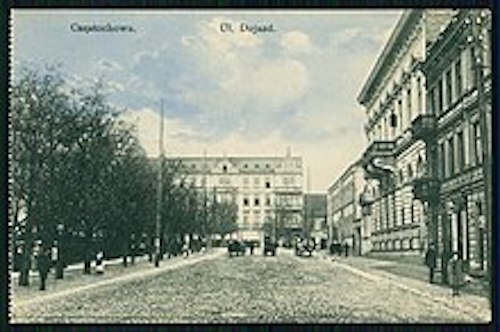 Czestochowa, Poland, early 20th century.
Czestochowa, Poland, early 20th century.
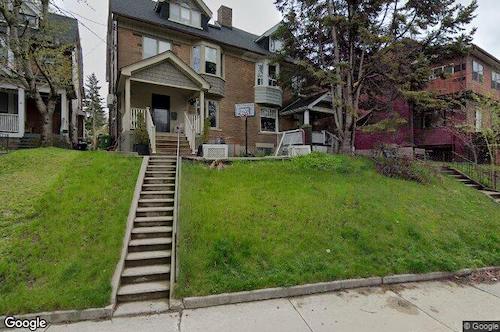 37 Indian Road, Toronto (modern view).
37 Indian Road, Toronto (modern view).
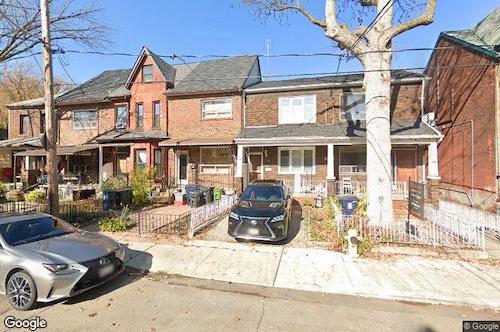 698 Adelaide St. W., Toronto (modern view).
698 Adelaide St. W., Toronto (modern view).
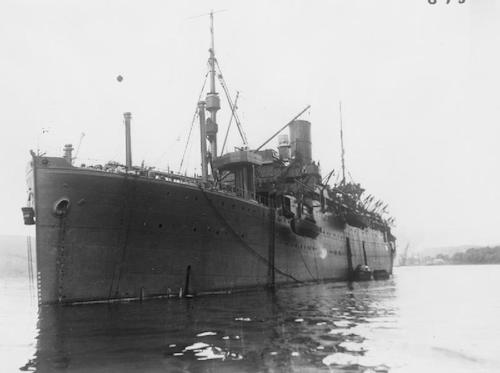 RMS Ascania 1923.
RMS Ascania 1923.
 RMS Ascania 1925.
RMS Ascania 1925.
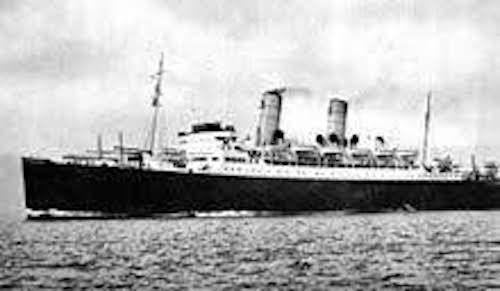 RMS Duchess of Atholl.
RMS Duchess of Atholl.
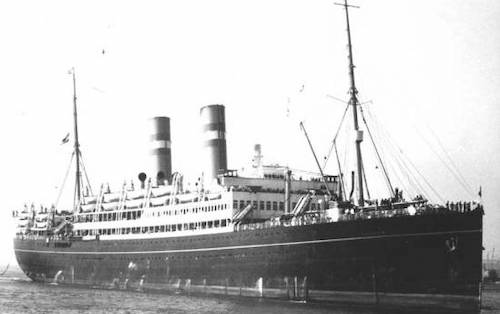 The_Volendam_ Volendam, built 1922, damaged by U-boat 1940.
The_Volendam_ Volendam, built 1922, damaged by U-boat 1940.
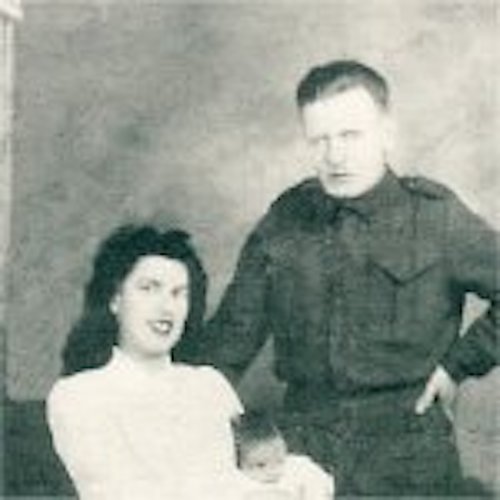 Elizabeth, Josef, and Camille Poniedzielski.
Elizabeth, Josef, and Camille Poniedzielski.
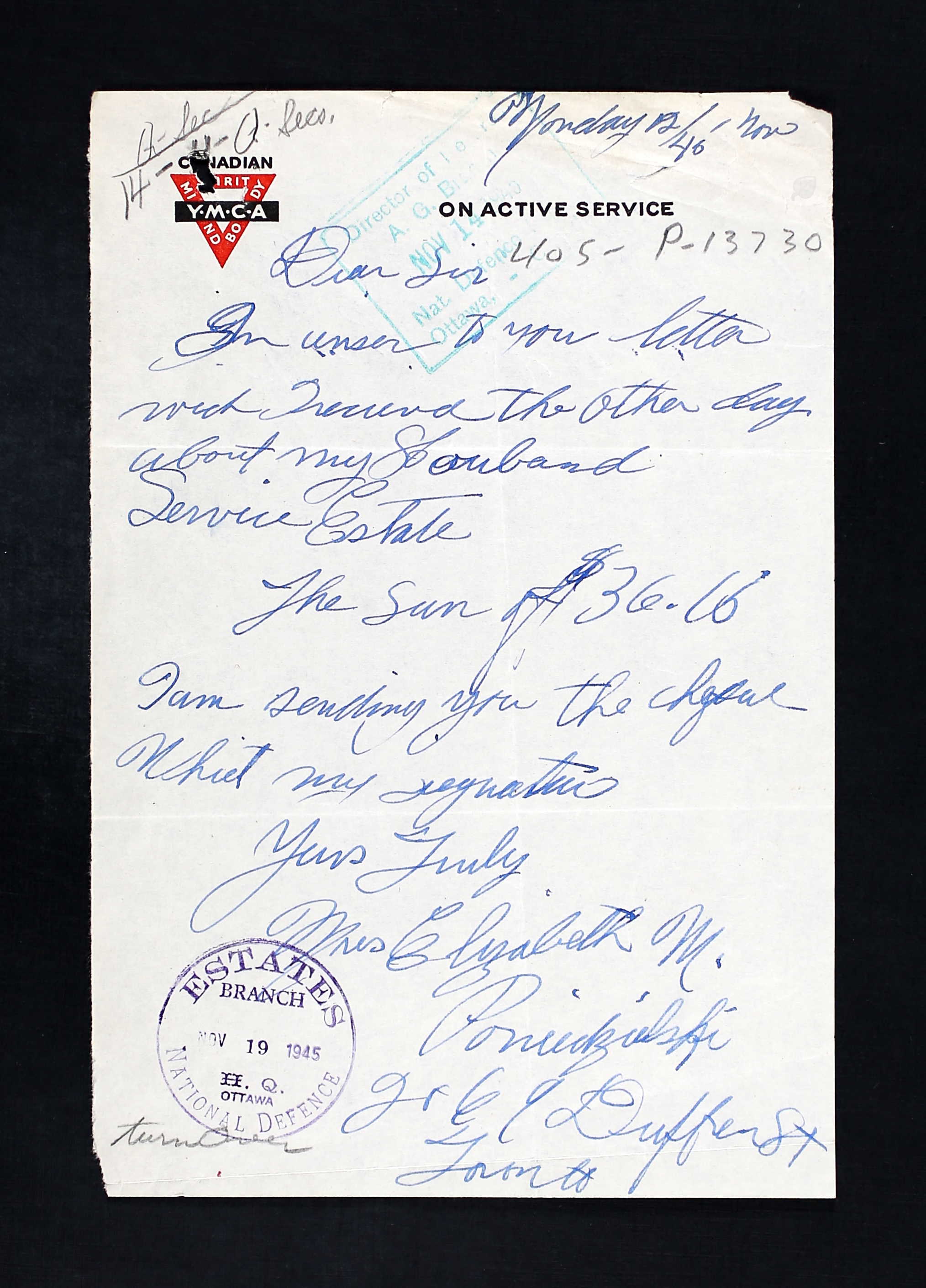 Letter from Elizabeth M. Poniedzielski to the Director of Records, 1 Nov. 1946.
Letter from Elizabeth M. Poniedzielski to the Director of Records, 1 Nov. 1946.